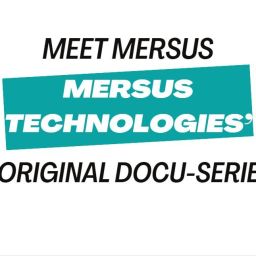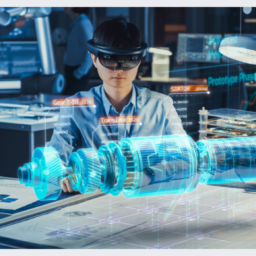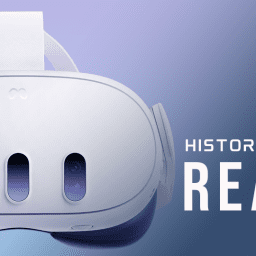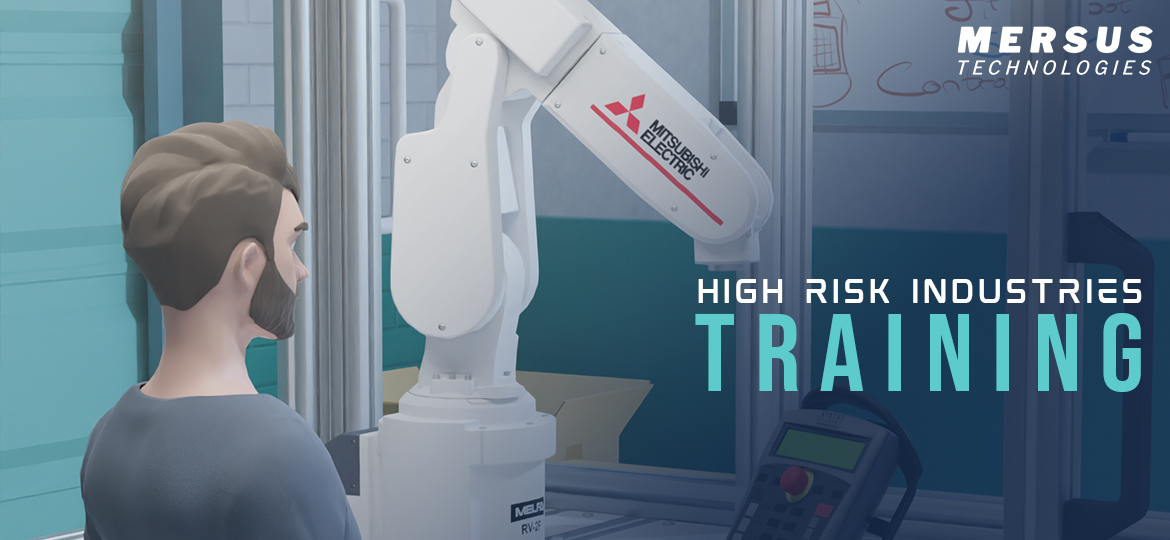
Virtual Reality in 2025 has begun its journey in actively revolutionising industries across multiple sectors. Perhaps one of the best use cases of VR is in industries where safety is paramount and non-negotiable; examples of these industries include manufacturing, energy, BioPharma, and aviation. Due to the nature of work carried out in these sectors, compliance training is both fundamental and foundational for all past, present, and future employees. Yet traditional training approaches often fall short in preparing teams for the complexity and urgency of high-risk procedures, processes, and environments. As a result, businesses like ours (Mersus Technologies) are actively developing experiences that are besting these shortcomings in virtual reality, providing a truly transformative solution.
We do this through simulating real-world scenarios in a safe, repeatable, and immersive environment. Empowering numerous organisations to upskill their workforce more effectively and, more importantly safely in the constraints of virtual reality. As such, this week’s blog post explores the limitations of conventional compliance training, the advantages of immersive VR solutions, and the measurable impact seen across varying industries.
Rethinking Traditional Compliance Training
As it stands, traditional compliance training typically includes classroom instruction, paper-based manuals and static e-learning modules. These methods, often popular due to their believed cost-effectiveness, regularly fail to engage learner or provide the learner the level of realism that is necessary for true preparedness in industries such as manufacturing and BioPharma. Research studies have identified three key areas where traditional compliance training is failing employees, these are:
- Passive Engagement: Learners tend to retain less information when training is delivered in a passive format. According to a PwC study, VR-trained employees completed training four times faster than classroom learners and were 275% more confident in applying what they had learned.
- Limited Practice: In industries where equipment, protocols, and timing are critical, trainees often don’t get the opportunity to rehearse real-world procedures. This creates a knowledge gap that only becomes apparent under pressure—when it matters most.
- Simulation Constraints: Emergency scenarios, such as chemical spills or electrical failures, are difficult to stage without risking safety or interrupting operations. Live drills can be costly and logistically challenging, reaching only a fraction of staff at a time.
These limitations highlight the need for a more immersive, accessible, and practical approach to safety and compliance.
An example of a traditional training method
The Virtual Reality Advantage
As such, virtual reality is actively changing the paradigm by turning training into a fully immersive, experiential process. Actively benefiting learners by allowing them to interact with realistic simulations that mirror their actual working environments, developing both procedural knowledge and confidence. There are a multitude of advantages to integrating virtual reality into your onboarding processes; however, for the purposes of this blog post, we are highlighting four key benefits that would positively impact high-risk industries.
High-Risk Benefits:
- Realism & Interactivity: VR creates lifelike simulations that enable learners to practice in a consequence-free environment. Whether operating complex machinery or responding to critical incidents, employees can build muscle memory and decision-making skills. An example is where a U.S. Air Force maintenance unit noted that with virtual reality, they can train technicians on tasks like landing gear repairs “without the risk of damaging actual aircraft,” letting them practice heavy tasks in a realistic but controlled setting.
- Safe, Repeatable Learning: With Virtual Reality, employees can repeat training modules as needed, reinforcing best practices without risk. This aligns with the concept of deliberate practice—a method shown to improve skill retention significantly over time. One such example is where chemical plant workers can go through an emergency spill response—if they make a mistake in VR, no one gets hurt.
- Data-Driven Performance Tracking: VR platforms such as our own Avatar Academy provide rich data analytics, tracking learner actions such as response time, decision accuracy, and procedural adherence. This allows training programmes to be tailored and improved based on real user data.
- Scalable and Cost-Effective: Once developed, VR modules can be rolled out across multiple locations, reducing the costs associated with travel, venue hire, and instructor time.
Due to these benefits, VR training directly tackles the weaknesses of traditional compliance education. Simulations provide engaging, hands-on, and realistic learning experiences that are also repeatable and measurable. Moreover, employees can practice dangerous tasks without risk, get immediate feedback, and build genuine proficiency. Therefore, this results in the training experience being more impactful, and organisations benefit from better-prepared, safer workers and richer data on training effectiveness.
To better illustrate the comparison of training methodologies and results, please see below the table that shows the aspect of a training module and how the learner fares in each training scenario.
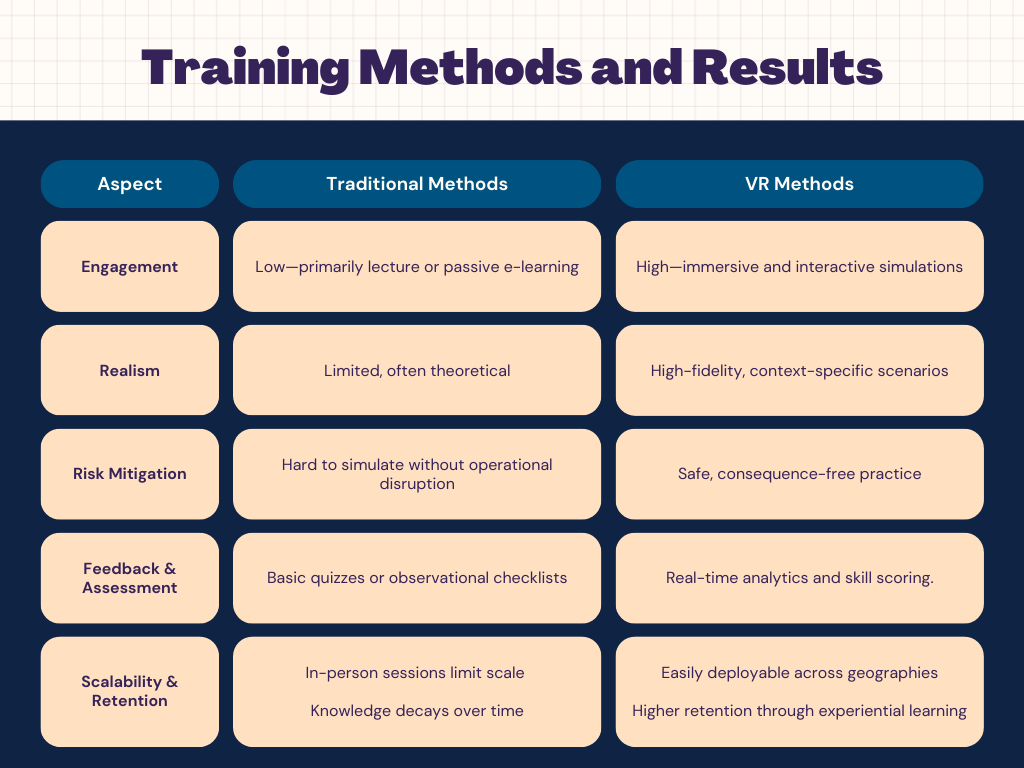
Traditional Methods vs VR Based Training
Industry Case Studies
We are not the only ones championing the integration of virtual reality in your onboarding and upskilling processes; there are numerous case studies that illustrate the points covered in this blog post as well. Three such studies are:
- Tyson Foods
To address workplace safety in its high-paced facilities, Tyson Foods introduced VR safety training. The results were impressive—over the course of a year, incidents decreased by more than 20%. Amy Vinson, the company’s safety analytics director, noted that VR significantly improved employee engagement with safety content.
- Boeing
As part of its assembly training, Boeing integrated VR and XR to support high-precision tasks. The result was a 90% improvement in first-time quality, significantly reducing production errors.
- Oil & Gas
A leading oil and gas firm implemented VR hazard awareness assessments across its worksites. According to a McKinsey report, the initiative led to a 55% reduction in recordable safety incidents within six months, alongside a sixfold increase in proactive hazard reporting.
Broader Strategic Impacts
To conclude, virtual reality offers a targeted solution to the core challenges faced by organisations operating in high-risk environments. For leaders in EHS, HR, and Learning & Development, the focus remains on reducing risk, improving knowledge retention, and achieving these outcomes in a cost-effective, scalable way. VR delivers on all fronts—enhancing training effectiveness while supporting a safer, more resilient workforce.
The TLDR of why virtual reality is a game changer in high-risk industries is summarised in these four benefits:
- Risk Reduction
By enabling safe, immersive practice in hazardous scenarios, VR equips employees to act quickly and correctly in real-world situations—minimising workplace incidents and improving regulatory compliance.
- Increased Retention and Confidence
Immersive training experiences improve cognitive and procedural retention. Employees also report higher confidence after practicing in realistic, high-pressure scenarios.
- Cost and Time Efficiency
While initial setup may involve hardware and content development, the long-term benefits include fewer training-related disruptions, reduced travel, and a faster time-to-competence.
- Data for Continuous Improvement
VR platforms offer analytics that go beyond test scores, providing actionable data on employee behaviour, response accuracy, and training outcomes.
Looking Ahead: The Future of Training
As VR hardware becomes more accessible and content development continues to advance, immersive training will become a standard in compliance and safety education. The shift is not just technological—it’s strategic. Organisations that adopt VR are positioning themselves at the forefront of workforce readiness and operational safety.
We at Mersus Technologies partner with organisations across high-risk industries to develop immersive training programmes that deliver measurable results. From design to deployment, we create VR experiences that reflect your operational reality and compliance needs.
Contact us today to explore how our VR platform, Avatar Academy, can elevate your training strategy!

